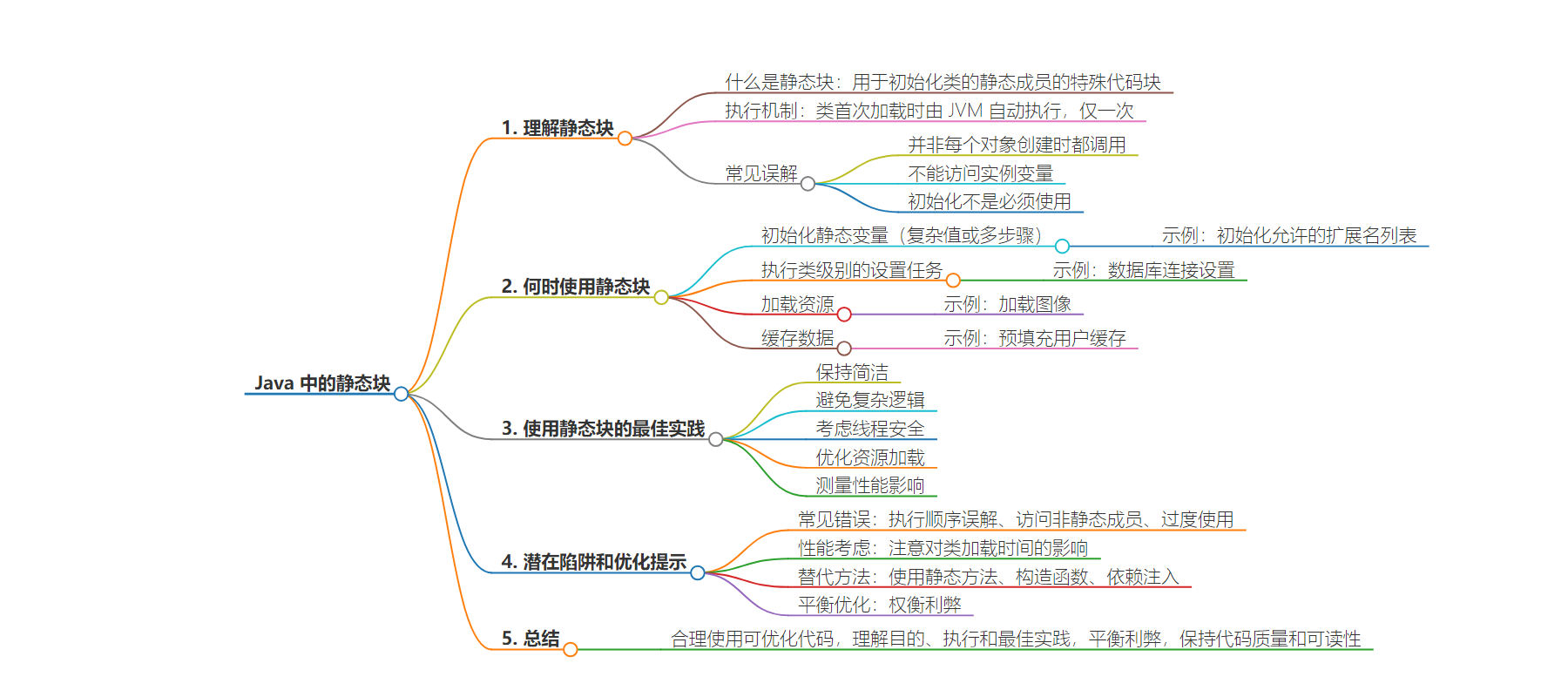包阅导读总结
1.
关键词:Java、Static Blocks、优化、性能、最佳实践
2.
总结:
本文探讨了 Java 中的静态块(Static Blocks),介绍其用途、执行机制、常见误区和最佳实践,强调合理使用可优化应用启动速度和性能,同时需注意潜在问题和替代方法以平衡利弊。
3.
主要内容:
– Static Blocks 简介
– 定义:与静态关键字相关,用于初始化类的静态成员
– 执行机制:JVM 在类首次加载时执行,且仅执行一次
– 常见误区:并非每个对象创建时调用、不能访问实例变量、不是初始化的必选项
– 使用场景
– 初始化复杂的静态变量
– 执行类级别的设置任务,如加载配置、注册组件、建立数据库连接
– 加载资源,如图片、配置数据等
– 缓存数据以提高性能
– 最佳实践
– 保持简洁
– 避免复杂逻辑
– 考虑线程安全
– 优化资源加载
– 衡量性能影响
– 潜在问题与优化提示
– 常见错误:如误解执行顺序等
– 性能考虑:注意对类加载时间的影响
– 替代方法:如使用静态方法、构造函数或依赖注入
– 总结
– 合理使用可优化性能,需平衡利弊,遵循建议以发挥潜力并保证代码质量和可读性
思维导图:
文章地址:https://www.javacodegeeks.com/2024/08/static-blocks-a-java-optimization-toolkit.html
文章来源:javacodegeeks.com
作者:Eleftheria Drosopoulou
发布时间:2024/8/2 12:30
语言:英文
总字数:821字
预计阅读时间:4分钟
评分:85分
标签:Java,性能优化,静态块,虚拟机,代码效率
以下为原文内容
本内容来源于用户推荐转载,旨在分享知识与观点,如有侵权请联系删除 联系邮箱 media@ilingban.com
In the realm of Java performance optimization, every millisecond counts. While often overlooked, static blocks can be a potent tool for enhancing application startup speed and overall efficiency. By understanding how and when to employ static blocks effectively, developers can significantly improve the performance of their Java applications.
This article delves into the intricacies of static blocks, exploring their purpose, mechanics, and best practices. We will uncover how to harness their power to optimize code execution, reduce initialization overhead, and create more responsive applications.
1. Understanding Static Blocks
What are Static Blocks?
A static block is a special block of code in Java that is associated with the static keyword. It’s used for initializing static members of a class. Think of it as a set of instructions that the Java Virtual Machine (JVM) executes automatically when the class is first loaded into memory.
How Static Blocks Are Executed
When your Java program starts running, the JVM loads the necessary classes. If a class contains a static block, the JVM executes the code within that block before anything else in the class. This happens only once, the first time the class is loaded. After that, the static block is never executed again, even if you create multiple objects of the class.
Common Misconceptions About Static Blocks
- Static blocks are called for every object creation: This is incorrect. Static blocks run only once, when the class is loaded, not for each object instance.
- Static blocks can access instance variables: This is also incorrect. Static blocks can only access static members of a class.
- Static blocks are necessary for initialization: While they can be used for initialization, they are not always required. You can also initialize static variables directly.
2. When to Use Static Blocks
Static blocks are commonly used to initialize static variables with complex values or when initialization logic requires multiple steps.
public class MyClass { private static final List allowedExtensions = new ArrayList(); static { allowedExtensions.add(".jpg"); allowedExtensions.add(".png"); allowedExtensions.add(".gif"); }}
In this example, the allowedExtensions list is initialized within a static block, ensuring it’s ready for use when the class is loaded.
Performing Class-Level Setup Tasks
Static blocks can execute any code needed for class-level setup, such as loading configuration files, registering components, or establishing database connections.
public class DatabaseConnection { private static Connection connection; static { try { // Load database driver Class.forName("com.mysql.jdbc.Driver"); // Establish database connection connection = DriverManager.getConnection("jdbc:mysql://localhost:3306/mydatabase", "user", "password"); } catch (ClassNotFoundException | SQLException e) { // Handle exceptions } }}
This example demonstrates how a static block can handle database connection setup.
Loading Resources
Static blocks can be used to load resources like images, sound files, or configuration data during class initialization.
public class ImageLoader { private static Image backgroundImage; static { try { backgroundImage = ImageIO.read(new File("background.png")); } catch (IOException e) { // Handle exceptions } }}
This code loads a background image into a static variable for later use.
Caching Data
Static blocks can be used to pre-populate caches with frequently used data to improve performance.
public class UserCache { private static Map userCache = new HashMap(); static { // Load initial user data into the cache // ... }}
By caching data in a static block, you can avoid redundant data retrieval and improve application responsiveness.
3. Best Practices for Using Static Blocks
To fully harness the potential of static blocks and avoid common pitfalls, it’s essential to follow these best practices:
| Best Practice | Description |
|---|---|
| Keep Static Blocks Concise | Aim for brevity. Complex logic can hinder readability and maintainability. |
| Avoid Complex Logic | Restrict to straightforward initialization tasks. Avoid intricate calculations or conditional statements. |
| Consider Thread Safety | Ensure thread safety for shared resources to prevent data corruption. Use synchronization or immutable objects. |
| Optimize Resource Loading | Prioritize efficiency when loading resources. Consider caching or lazy loading techniques to minimize performance impact. |
| Measure Performance Impact | Measure application performance before and after introducing static blocks to determine effectiveness. |
4. Potential Pitfalls and Optimization Tips
While static blocks offer advantages, it’s essential to be aware of potential issues and explore alternative approaches:
| Issue/Tip | Description |
|---|---|
| Common Mistakes | Misunderstanding execution order, accessing non-static members, overusing static blocks. |
| Performance Considerations | Be mindful of the impact on class loading time, especially for large static blocks. |
| Alternative Approaches | Consider using static methods, constructors, or dependency injection for certain initialization tasks. |
| Balancing Optimization | Weigh the benefits of static blocks against potential downsides like reduced readability or maintainability. |
5. Wrapping Up
Static blocks can be a powerful tool for optimizing Java code when used judiciously. By understanding their purpose, execution, and best practices, developers can effectively improve application startup time and overall performance. However, it’s crucial to balance the benefits of static blocks with potential drawbacks and consider alternative approaches when necessary. Follow the tips given in the article and you can harness the full potential of static blocks while maintaining code quality and readability.
